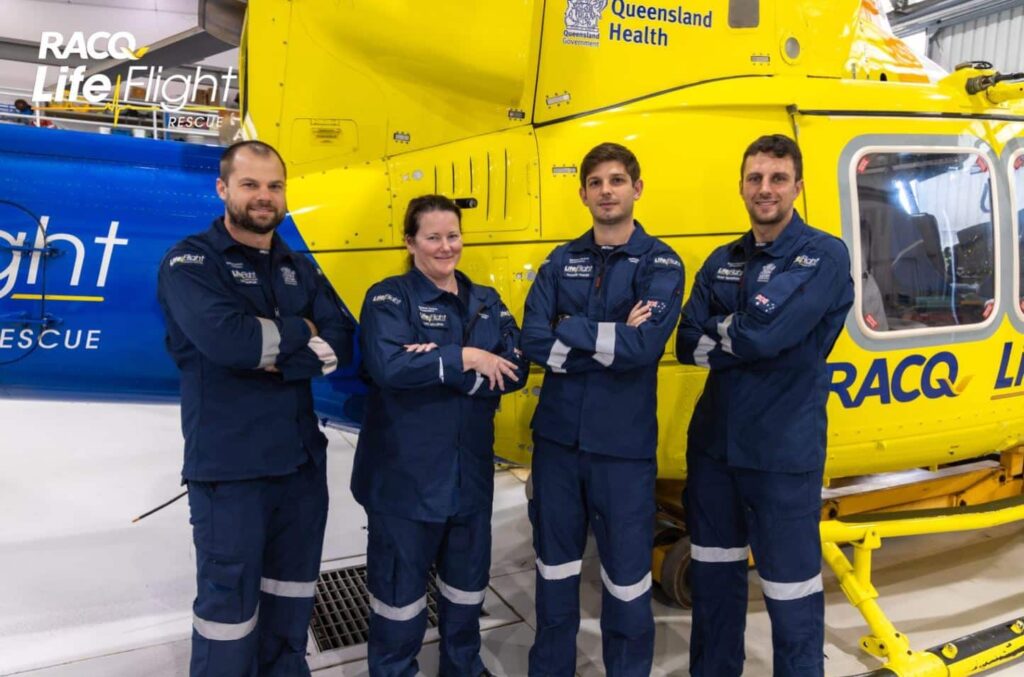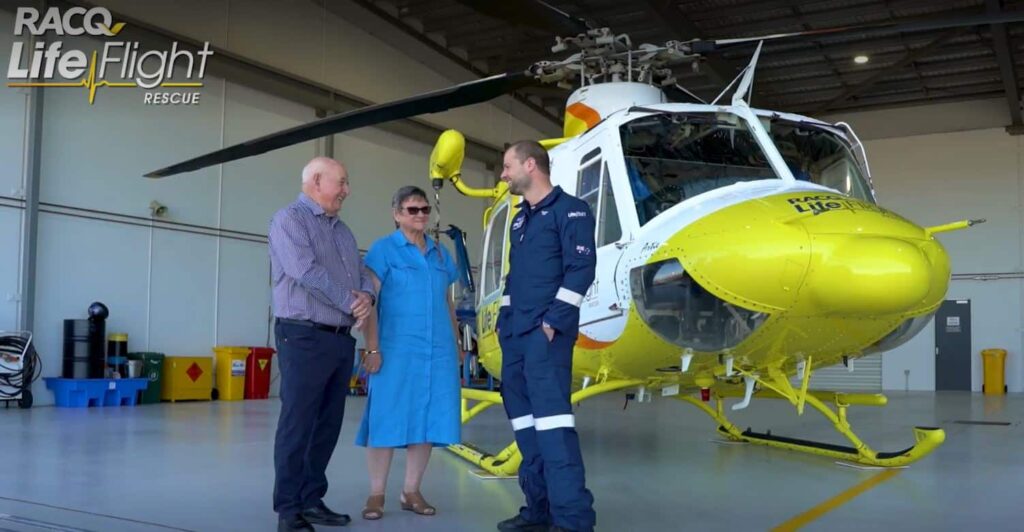
A team of critical care doctors, including Bundaberg born and bred Chris McMullen, recently started work aboard the Bundaberg-based RACQ LifeFlight Rescue helicopter.
The group will help to enhance the world-class aeromedical care already provided by the service, to the people of Wide Bay-Burnett.
The five highly qualified doctors are working alongside experienced aviators and Queensland Ambulance Service (QAS) flight paramedics, some of whom have been with the service for decades.
Newly-appointed LifeFlight Bundaberg Clinical Lead Dr Chris McMullen said it was great news for the region.
“We have a great bunch of paramedics who are actually quite experienced, they’ve been running this service for a number of years,” he said.
“Having the doctors on board will just enhance what they already offer to the community.”
LifeFlight Chief Medical Officer Dr Allan MacKillop said for 24 years the Queensland Ambulance Service flight paramedics had provided exemplary service working on the rescue helicopter out of Bundaberg.
“They have a high level of skills and it’s going to be a pleasure for the organisation to supplement those skills, with the skills of a Critical Care Doctor,” he said.
It was members of the local community who first identified a growing need in the region for doctors to be part of the RACQ LifeFlight Rescue aeromedical team.
Respected local philanthropists and long-time LifeFlight supporters Ron and Fay Simpson are passionate about the doctor project and are donating $740,000 through The Simpson Foundation.
“We could see the need for that critical care doctor here in our region; after all, it’s only a couple of regions that don’t have it and we thought well we will do what we can to make it happen,” Mr Simpson said.
The family was inspired by their own first-hand experiences with RACQ LifeFlight Rescue.
“Our grand-daughter had severe eye trauma from a motor mower accident from a stone thrown into her eye and she was airlifted to Brisbane,” Mr Simpson said.
“Also we had a premature grandson born at 27 weeks who needed to be airlifted quickly to Brisbane.”
The Simpsons’ initial donation guaranteed Phase One of the project, with critical care doctors currently on duty three days a week.
“The Simpson’s generosity has been extraordinary,” said Dr MacKillop.
“The work that we will be able to do with the funding that they have provided will ensure that the rescue helicopter aeromedical crew will be able to treat the most severely ill, or critically injured patients, that can present to a rescue helicopter service.”

LifeFlight’s local Regional Advisory Committee (RAC) members have worked tirelessly, fundraising and rallying the community to boost the original lead donation and ensure long term viability of the project.
Other organisations and community members have met the Simpsons’ challenge and given generously.
“The community identified the need in a certain number of missions that are flown, that critical care doctors are required,” said LifeFlight Wide Bay-Burnett Regional Advisory Committee Chair Neil McPhillips.
“The Regional Advisory Committee worked with LifeFlight in engaging with sponsors and donors to raise the funds required.
“It’s pretty exciting we’re at that stage where we see critical care doctors in LifeFlight uniforms jumping on a chopper and heading off on missions.”
While the doctors have vast medical experience and have worked on aircraft in the past, all were required to undergo specialised RACQ LifeFlight Rescue training, including lessons on winching and working outside a hospital environment.
“We’re going to insert these doctors and paramedics into the bush or remote areas, so they can perform their medical work on patients in restricted areas,” RACQ LifeFlight Rescue Checking and Training Officer Nathan Minett said.
“They do all their magic down there and then we can recover them back up to the aircraft.
“The doctor typically will accompany the patient on the way back up on the stretcher so we need to give them all the skill set, to make sure they’re safe and equipped to do that job.
“As members of the rostered crew, the critical care doctors are available to respond to emergency situations, search and rescue missions and perform aeromedical transfers.”
Dr Peter Henderson was first doctor out of the blocks, with a mission to transfer an elderly man to Bundaberg Hospital, after he suffered a suspected head injury when he fell from a horse while mustering cattle.
Dr Chris McMullen a proud local

Born and bred in Bundaberg, Clinical Lead Dr McMullen recently completed his first aeromedical tasking in his home territory, treating and transferring a seven-month old child who was suffering breathing difficulties.
He has previously been part of aeromedical crews on aircraft in other regions and is currently working as an emergency specialist at Bundaberg Hospital.
“Well everyone enjoys flying in helicopters but it’s something that the community really needs,” he said.
“Up until this point we didn’t have doctors assisting our paramedics between Rocky and the Sunshine Coast so it’s a great opportunity to be a part of it and try bring some of those intensive care type therapies to the roadside.”
Phase Two will see doctors working seven days a week with fundraising ongoing.
The ultimate goal is to secure enough funding to have critical care doctors on board the chopper 24/7, every day of the year.




